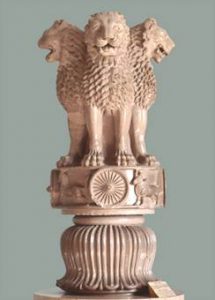Table of Contents
Buddhism shares the aim of overcoming the pain and fulfillment of Nirvana, the ultimate state of soteriological release. Let us experience the sterling teaching of Gautam Buddha at the great Sanchi Stupa, the monument which reflects the gem of Buddhist art and architecture.
“Better than a thousand hollow words is the word that brings peace.”- Gautam Buddha
Sanchi Stupa is one of the oldest stone structures in India constructed during the Mauryan period. The sculptures, monuments and lush gardens of Sanchi Stupa have been selected as the World Heritage site by UNESCO.
Grab Latest Study Materials! Register Here!
Sanchi is a small village situated at the foothill very near to the capital city of Madhya Pradesh, Bhopal. The place attracts tourists from across the world with its ancient Stupas, monasteries and prosperous Buddhist culture. The Great Stupa at Sanchi is one of the best-preserved Stupas with its ornamental gateways alluring thousands of pilgrims and travellers. Following is a full guide of Sanchi Stupa that will reveal interesting facts about the same.
In ancient Indian history, Mauryan dynasty had an important role. Sanchi Stupa is the best example of Mauryan sculpture. Learning about Sanchi Stupa is important for IAS Exam from the view of Art & Culture section of the syllabus.
NCERT notes on the topic ‘ Sanchi Stupa & Lion Capital’ are helpful for the UPSC preparation. These notes will also be helpful for other competitive exams like banking PO, SSC, state civil services exams and much more.
Attempt Free GK Test! Download Entri App!
Sanchi Stupa – Lion Capital, Sarnath
- One of the best examples of Mauryan sculpture.
- Situated at Sarnath, near Varanasi. Authorized by Emperor Ashoka. Constructed in 250 BCE.
- Made of polished sandstone. The surface is heavily polished.
- At present, the pillar is in its original place but the capital is displayed at the Sarnath Museum.
- It was authorized to observe the first sermon of the Buddha or the Dharmachakrapravartana at Sarnath.
- At first, the capital had five components:
- The shaft (now broken into many parts)
- A lotus base bell
- A drum on the base bell with 4 animals proceeding clockwise (abacus)
- Figures of 4 lions
- The crowning part, a large wheel (this is also broken and displayed at the museum)
- The capital was embraced as the National Emblem of India after independence without the crowning wheel and the lotus base.
- The four lions are seated back-to-back on a circular abacus. The figures of the lions are grand and arouse magnificence. They are realistic images and the lions are created as if they are holding their breath. The curly manes of the lions are large. The muscles of the feet are shown stretched showing the weight of the bodies.
- The abacus has four wheels (chakra) with 24 spokes in all four directions. This is part of the Indian National Flag now.
- The wheel portrays Dharmachakra in Buddhism (the wheel of dhamma/dharma). Between every wheel, there are animals engraved. They are a bull, a horse, an elephant and a lion. The animals appear as if they are in movement. The abacus is held by the inverted lotus capital.
Attempt Free GK Test! Download Entri App!
Sanchi Stupa
- Sanchi Stupa is a UNESCO world heritage site since 1989. Sanchi is located in Madhya Pradesh.
- There are many small stupas here with three mains ones – stupa 1, stupa 2 and stupa 3. Stupa 1 is also called the Great Stupa at Sanchi. It is the most famous and the oldest and is believed to have the Buddha’s relics.
- It was constructed by Ashoka in the 3rd century BCE.
- At first, it was smaller than its current dimensions. It was enlarged in later periods.
- The original structure was built out of bricks. Later on, it was covered with stone, vedica, and the torana (gateway).
- There are four gateways to the stupa with the southern one being built first. The others were built later. The gateways are decorated with beautiful sculptures and engravings. Each torana comprises of two vertical pillars and three horizontal bars on top. The bars have beautiful carvings on front and back. They consists images of shalbhanjikas – lady holding the branch of a tree. Stories from the Jataka tales are engraved here.
- The structure has a lower and upper pradakshinapatha or circumambulatory path. The upper pradakshinapatha is exclusive to this stupa.
- On the southern side of the stupa, the Ashokan Lion Capital pillar is seen with carvings on it.
- The hemispherical dome of the stupa is called the anda. It has the relics of the Buddha.
- The harmika is a square railing on top of the dome/mound.
- The chhatra is an umbrella on top of the harmika. There is a sandstone pillar in the site where Ashoka’s Schism Edict is carved.
- The original brick dome was enlarged into double its size during the rule of the Shunga dynasty with stone slabs covering the original dome.
Grab Latest Study Materials! Register Here!
Sanchi Stupa Architecture
Sanchi Stupa is known for its exclusive architecture. Anda, Harmika, Chhatra, and many other parts of the Great Stupa can be experienced by visiting the site. This place is also surrounded by some of the most captivating places in Bhopal. Following are the three fundamental features of Sanchi Stupa.
1. A hemispherical mound called Anda
The domed shape Anda with green highlights depicts the mound of dirt that was used to cover Lord Buddha’s remains. It has a solid core that cannot be entered. The earliest Stupas consisted of the real relics of the Buddha where the relic room was buried deep inside the anda, called tabena. With the flow of time, the hemispherical mound has taken the symbolic connection defining the mountain home of the gods at the centre of the universe.
2. A square railing called Harmika
The Harmika that’s the red highlights is motivated by a square railing that encloses the mound of dirt, making it a blessed burial place.
3. A central pillar supporting a triple umbrella form called Chattra
The Chattra was obtained from the umbrella, placed over the mound to protect it from elements. As the symbolic value of Anda enlarged over time, the central pillar that holds the umbrella was set to display the pivot of the universe. The three circular umbrella-like disks display the three jewels of Buddhism; that’s Buddha, Dharma and Sangha.
Around these three fundamental blocks of Sanchi Stupa, the following are some secondary establishments:
- Toranas:
It’s the wall with trademark i.e. three horizontal stone bars, surrounding the entire site. The wall is marked in light blue highlights with toranas in yellow.
- Medhi:
It’s the terrace surrounded by a three-bar railing. It supports the Anda and raises it off the ground. It serves as the platform for ritual circumambulation.
Attempt Free GK Test! Download Entri App!
Interesting Facts About Sanchi Stupa
Sanchi Stupa facts attracts history lovers from all over the globe. From its establishment till the present-day the Great Stupa has ungergone several changes. The following are the interesting facts and features of Sanchi Stupa in Bhopal:
- Sanchi Stupa was authorized by Emperor Ashoka and managed by his queen Devi and daughter Vidisha.
After the emperor accepted Buddhism, he constructed the first stupa at Sanchi followed by many more in the later years. - Sanchi Stupa was left abandoned and undiscovered from the 14th century until the year 1818 when General Taylor refound the site.
- Sir John Marshall established an archaeological museum here in 1919, which is at present known as Sanchi Museum.
- The pillar of Sanchi Stupa has an Ashokan inscription known as Schism Edict. It also has an carving in the ornamental Sankha Lipi from the Gupta period.
- It’s the oldest stone structure in India.
- Sanchi Stupa has many number of Brahmi engravings.
- At present, this Stupa is 36.5 m in diameter and 21.64 m high.
- The place has historical importance, however, Lord Buddha never came to this place.
- The famous Ashoka pillar consisting of four lions is also found in Sanchi. These pillars are constructed in a Greco-Buddhist style.
- Sanchi Stupa architecture was announced as the world heritage in the year 1989.
Connection with Buddhism
- Surprisingly, Buddha never visited Sanchi.
- Foreign travelers like Hiuen Tsang, who taped the famous Buddhist circuit in India but didn’t mention Sanchi in his books, didn’t know either.
- Sanchi was not as admired as other Buddhist pilgrimage places in India, according to Marshall’s The Monuments of Sanchi (1938).
- The iconic images of Buddha (like the Bodhi tree, a riderless horse, an empty throne, etc.) at Sanchi, according to scholars like Alfred A Foucher, are the result of Graeco-Buddhist architectural interaction.
Attempt Free GK Test! Download Entri App!
I hope this article was helpful. The key point to clear an exam lies in methodical and planned preparation. If you are a candidate who wants to pursue your dream career and looking for a good start, our Entri app has got it covered for you. Our team will help you with content and insights related to the topics of your concern. Subscribe to our app today and enrol yourself into various programmes our app offers. Tune in to the app to stay updated regarding various aspects of the subject you are interested in. Feel free to post any queries and doubts in the comment section. We will try our best to reach out. Push away all those self-doubts and negative thoughts. Try to have a clear vision. Ask yourself why you want this. Focus on the good and work hard.















